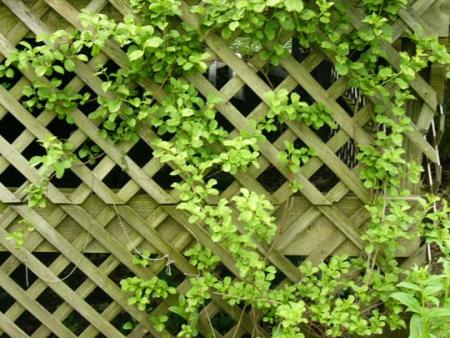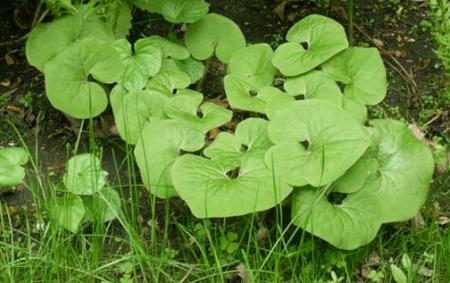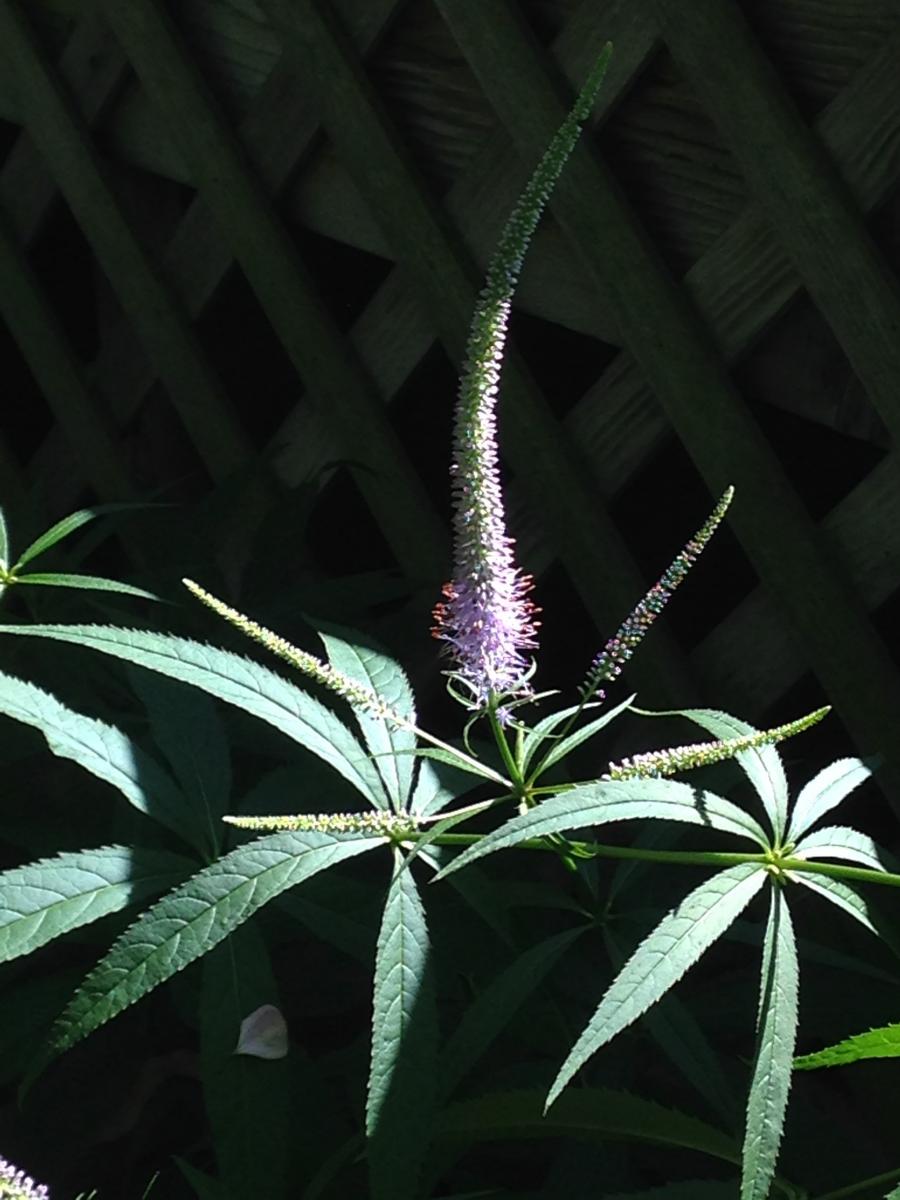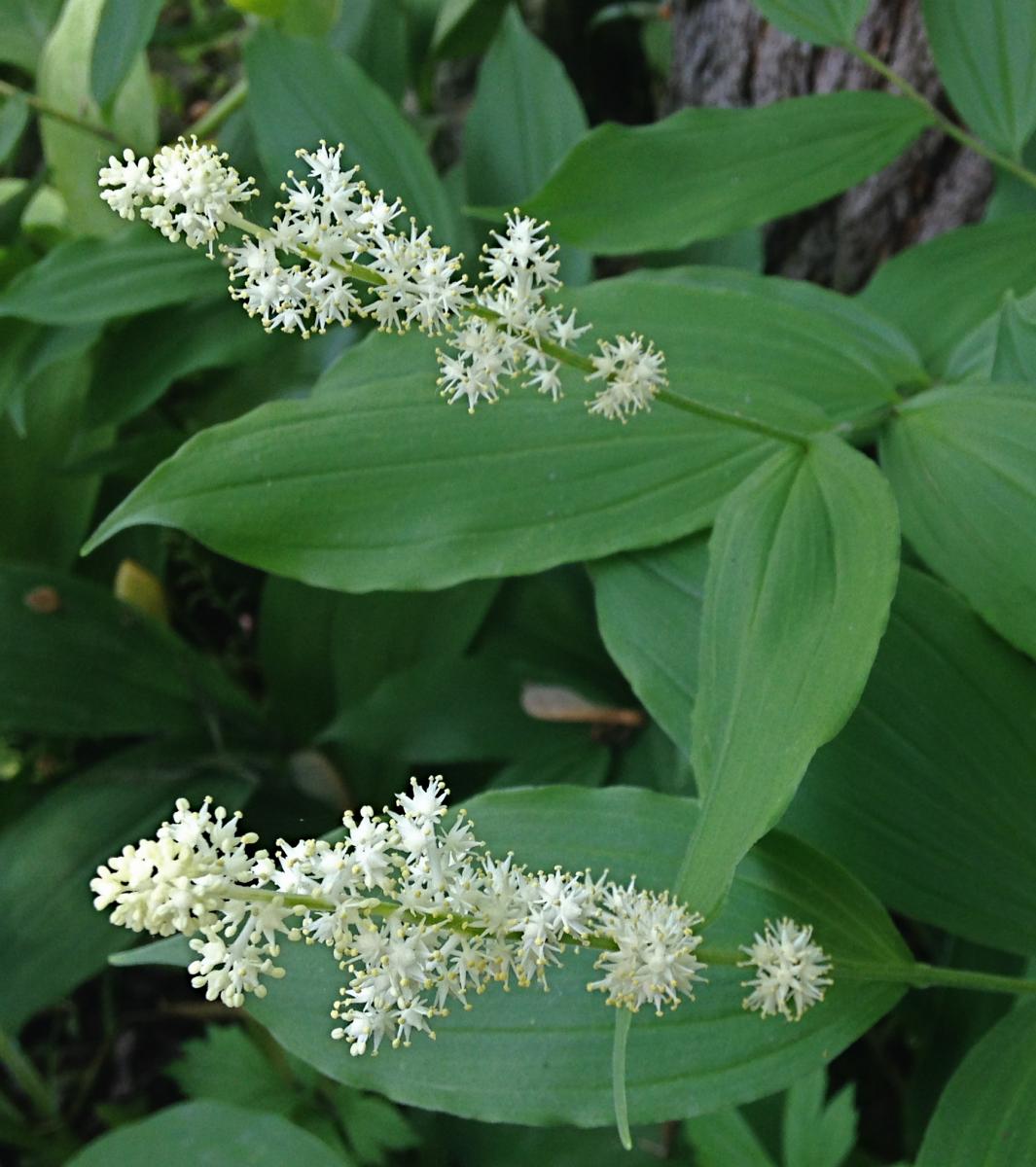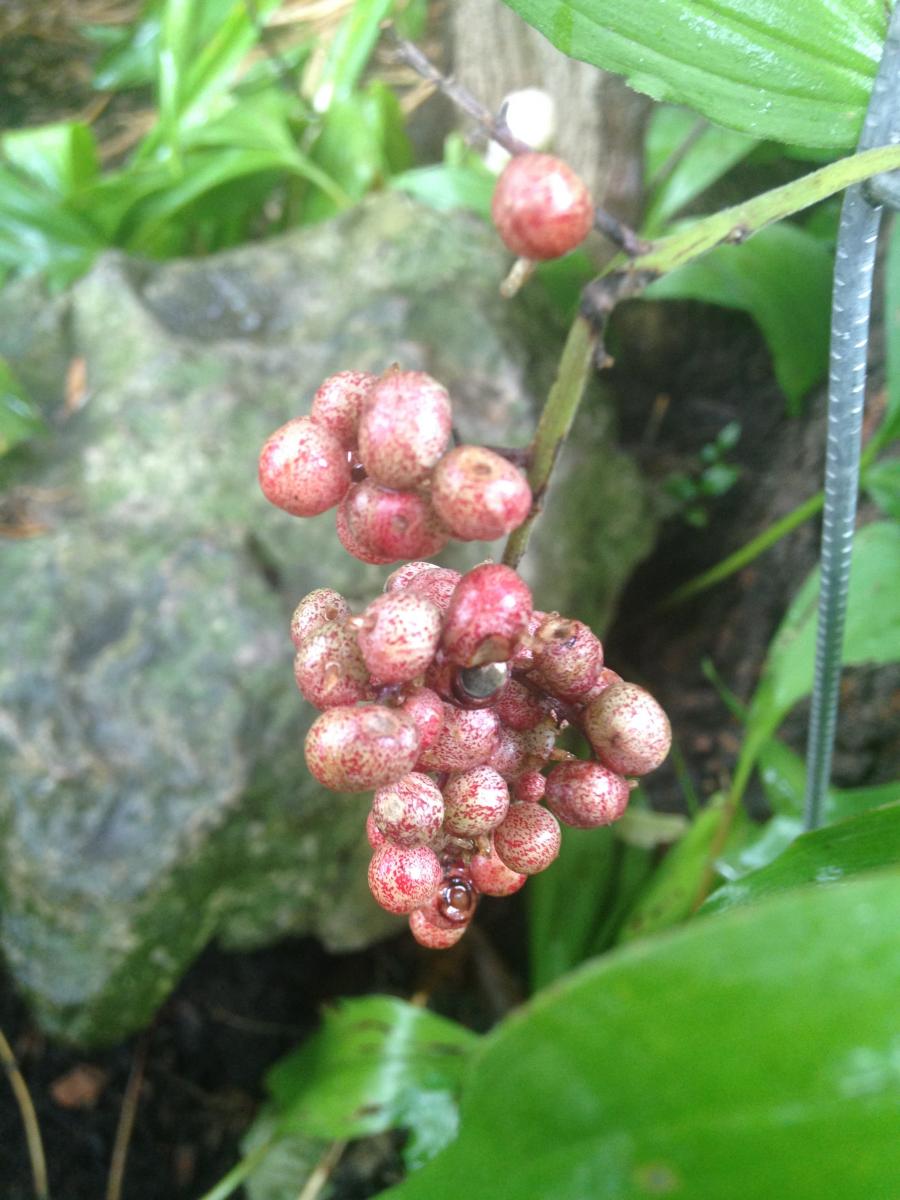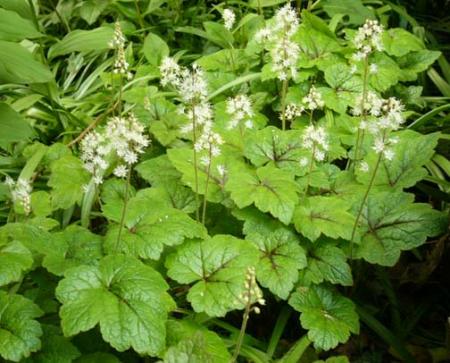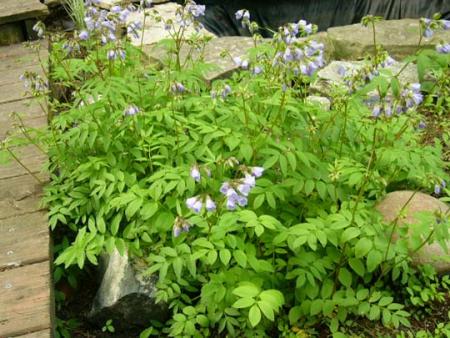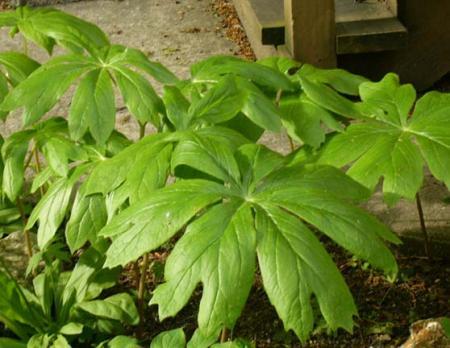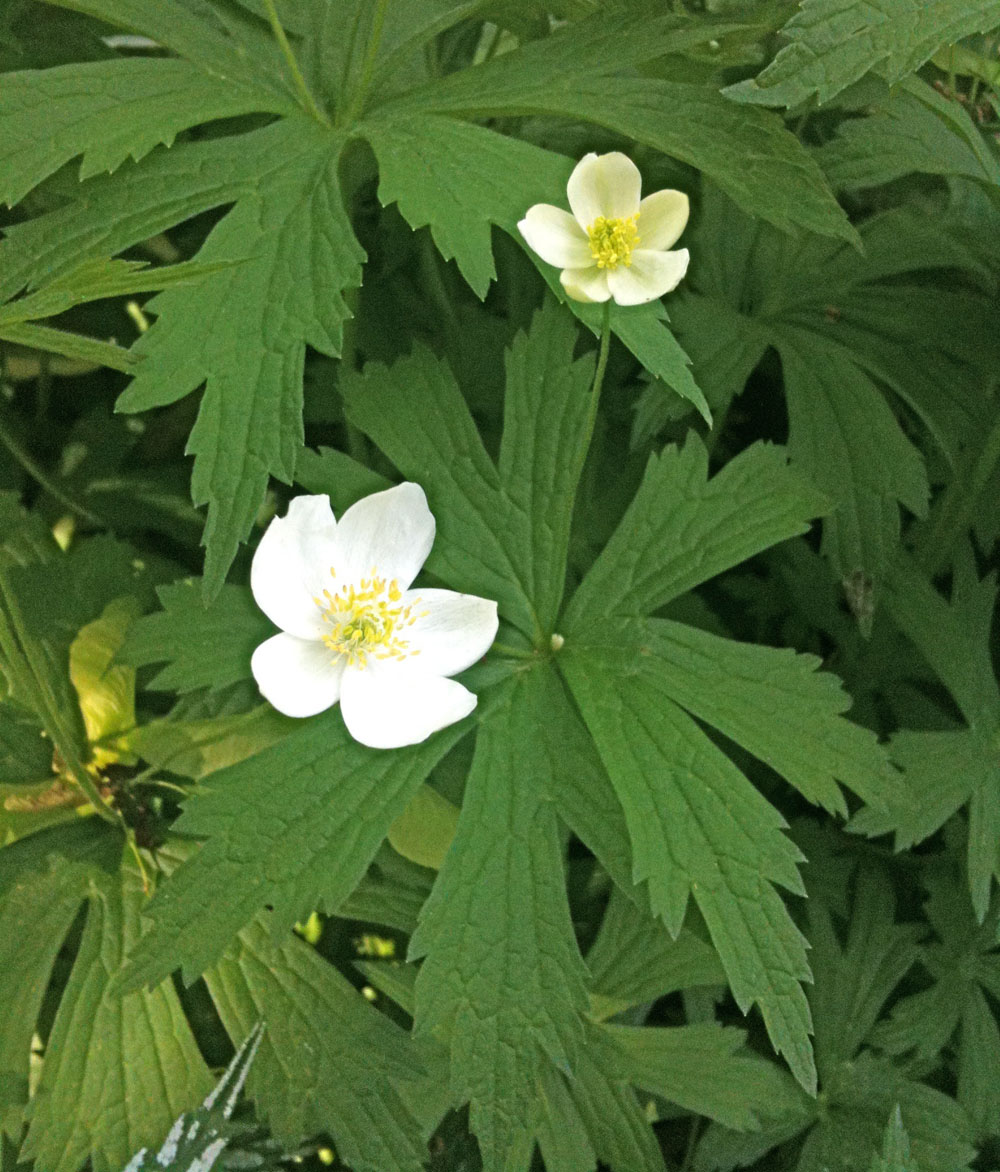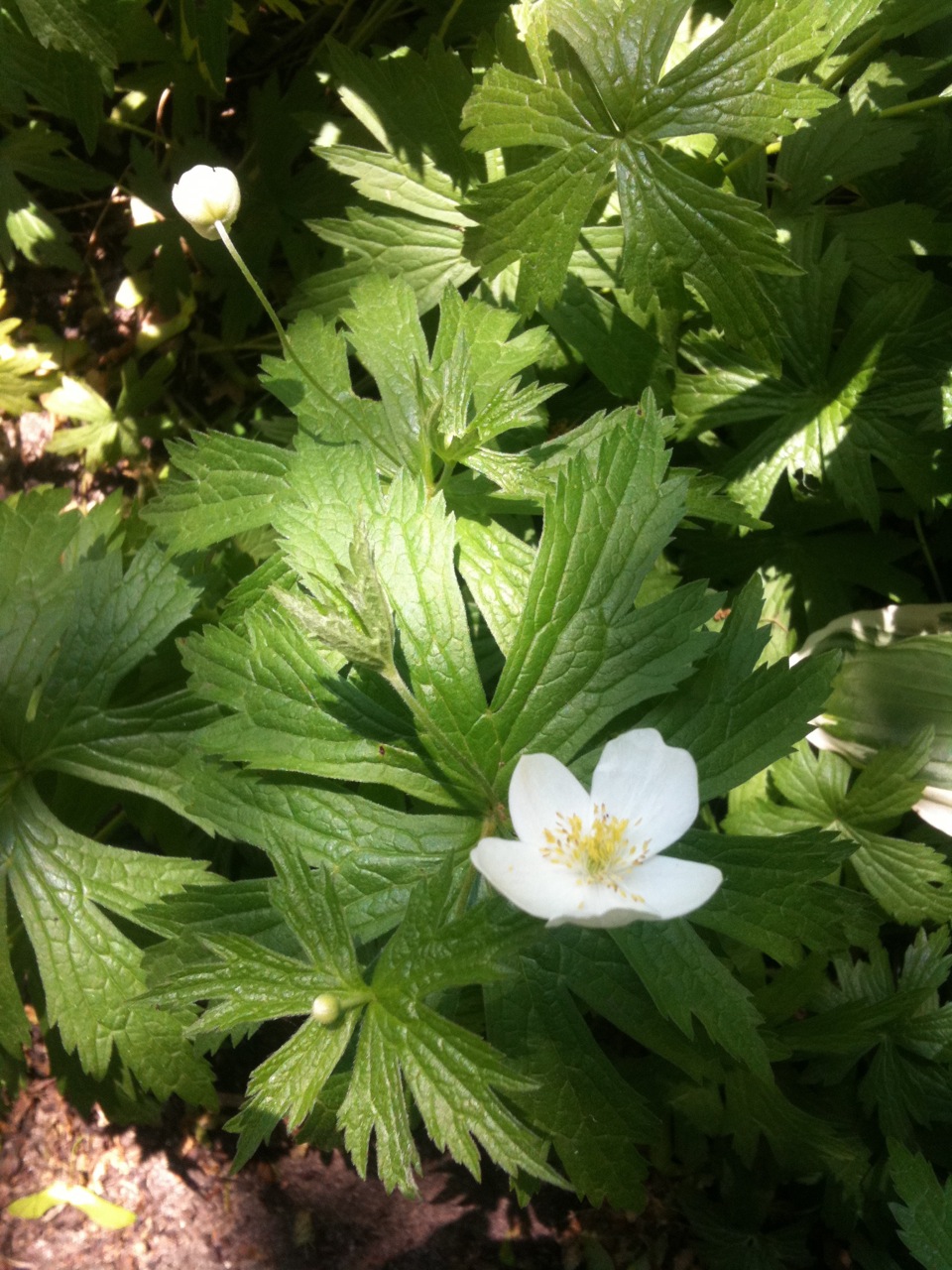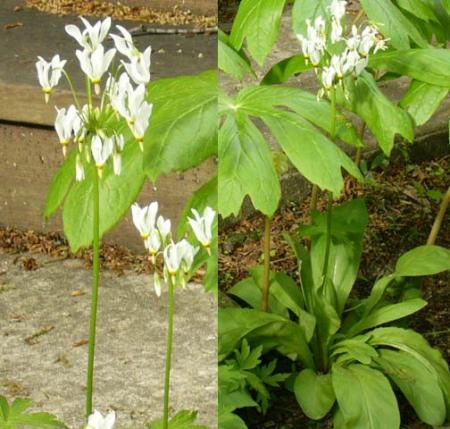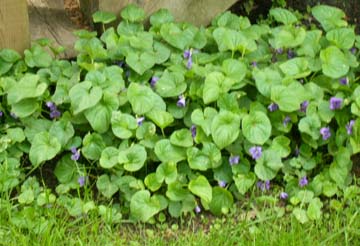Gardening with Native Plants in Shady Evanston
I love that we're a Tree City, but if, like me, your yard is shaded by some big ones, growing stuff at ground level can be a challenge. For years I've asked greenhouses and nurseries, what does well in shady places where there's still snow into April? "Moss," and "mushrooms," they usually laugh, but I'd hoped for something leafier.
My wife and I inherited some of the ubiquitous Evanston shade plants: hosta, euonymus, pachysandra, and lilies of the valley. We also had success adding some bishop's-hat (epimedium), false lamium, lungwort, and spotted dead nettle. But until about a decade ago, most of the perennials in my woodlands area were cultivars from Europe or Asia.
Since then I've learned how important it is to our remaining forests and prairies, and to wildlife from humble honeybees all the way up to the top of the food chain, to prevent the spread of non-native species. The best way to do that is by planting what used to grow here naturally.
I haven't ripped out a lot of my foreigners, but for anything new I put in, I've looked for plants native to Illinois, or at least midwestern or northern U.S. native species. As it turns out, these species are often the best suited for a garden in Illinois, and will succeed where some imports fail. Plus, finding them is sometimes an adventure.
I started this "book" with a dozen pix from my garden. To read it, click links below. Each "page" then provides links to the next or previous page. If you want, you can leave the book and just tour the Image Gallery, where you can see bigger pictures. I originally put the same text in each, but this book now has more.
This book will be an ongoing project, to photograph and describe some of the alternatives to the usual suspects. While it's addressed to "shady Evanston," it applies equally well to anywhere shady and/or moist in WIlmette, Rogers Park, anywhere along the North Shore or north Chicago lakefront, or for that matter most of Chicagoland (although the microclimate has more extremes inland). Some are hard to track down; others are no further a hunt than your own lawn (or at least mine). Because it's a "book," it is collaborative; feel free to add your own contributions and comments!
- Log in to post comments
American bittersweet
American bittersweet Celastrus Scandens is a native (but see note below) woody-stemmed perennial vine with short, softly ovalled, slightly toothed, often shiny leaves that taper to a point. Left to its own devices it will trail out in a mass along the ground, but it will also climb and ornament posts and trellises, and so it's an alternative to non-native Euonymous or English ivy.
It can be planted at any time during the growing season except in high heat; it needs at least partial sun. American bittersweet should not be confused with Bittersweet Nightshade Solanum dulcamara, nor with Oriental Bittersweet, Celastrus orbiculata, an invasive, lookalike Asian variety which has rounder leaves and is starting to crowd out the native variety in many American forests.
Update: Numerous recent sources I've read indicate that most bittersweet being sold at nurseries is the non-native variety. Also, the invasive may be self-hybridizing with the native variety. For that reason, guides are saying "don't plant bittersweet" at all unless you can be 100% certain it's 100% American bittersweet.
- Log in to post comments
Black snakeroot (a/k/a black cohosh; bugbane)
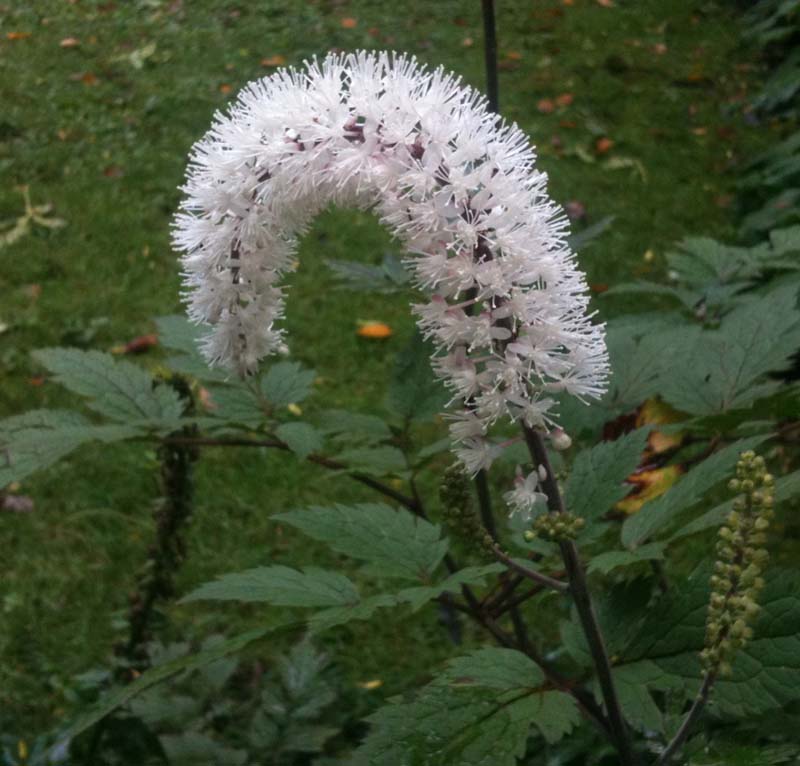 Black snakeroot, Actaea racemosa, is a delicate, shade-tolerant, moisture-loving woodland perennial native to the eastern and midwestern states. It is a threatened species in Illinois. Used medicinally by native Americans and settlers, it's also called black cohosh, black bugbane, or just bugbane. You are very likely to find it sold as Cimicifuga racemosa, because there has been botanical confusion and controversy over its genus.
Black snakeroot, Actaea racemosa, is a delicate, shade-tolerant, moisture-loving woodland perennial native to the eastern and midwestern states. It is a threatened species in Illinois. Used medicinally by native Americans and settlers, it's also called black cohosh, black bugbane, or just bugbane. You are very likely to find it sold as Cimicifuga racemosa, because there has been botanical confusion and controversy over its genus.
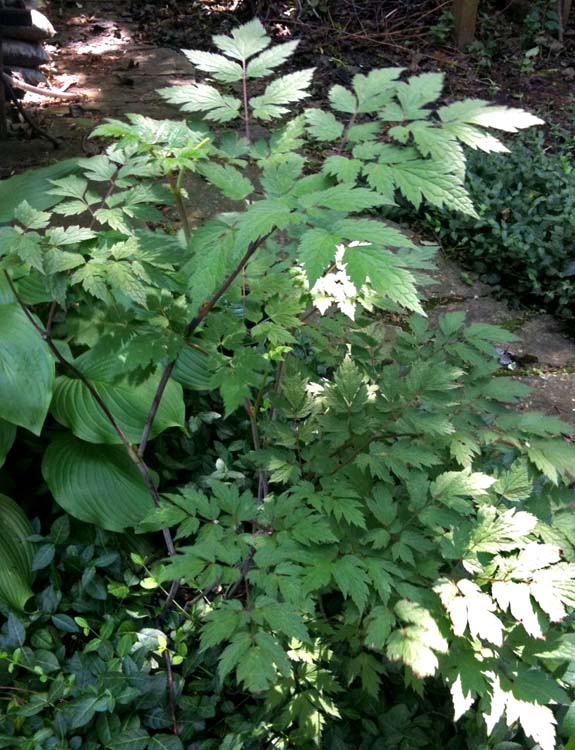
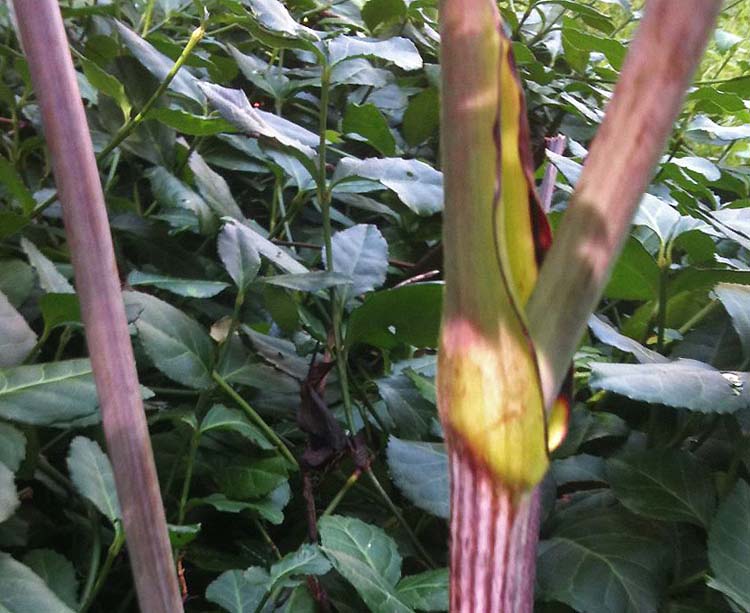 Black snakeroot has burgundy-colored stems (right) and heavily serrated three-part leaves, and puts out tall, curvy, wand-like flowers in late summer or fall. It wilts in heat or dryness, in my experience, and needs some care to establish; it may need support from windstorms, and so does better planted in multiples rather than as a single specimen. When looking for this plant, don't get mixed up with the similarly-named "common black snakeroot," Sanicula odorata, a low-growing member of the carrot family. Check the Latin to be sure.
Black snakeroot has burgundy-colored stems (right) and heavily serrated three-part leaves, and puts out tall, curvy, wand-like flowers in late summer or fall. It wilts in heat or dryness, in my experience, and needs some care to establish; it may need support from windstorms, and so does better planted in multiples rather than as a single specimen. When looking for this plant, don't get mixed up with the similarly-named "common black snakeroot," Sanicula odorata, a low-growing member of the carrot family. Check the Latin to be sure.
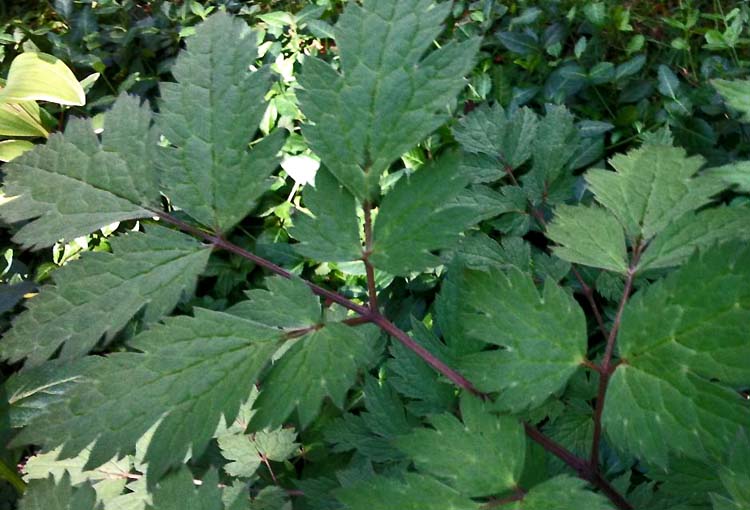
- Log in to post comments
Bloodroot
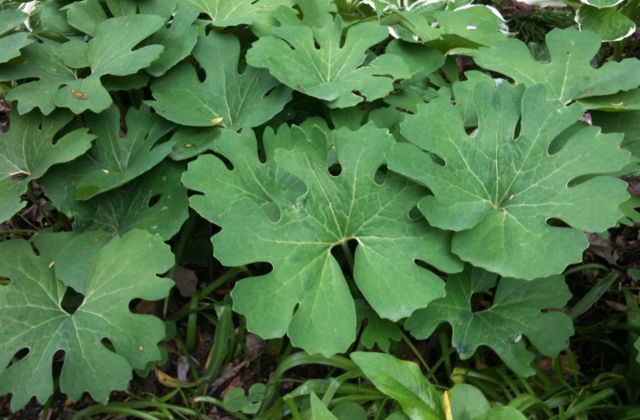 I suspect that the scary-sounding common name of Sanguinaria canadensis, a member of the poppy family, is the main reason you don't see this shade perennial much in gardens or even in nurseries. I found it listed in some native plant guides as yet another candidate for my shady, moist woodlands area, and finally scored some from an elderly greenhouse worker in Chicago who brought me some from her own garden. The name, however, comes from the fact that Native Americans used the root to make a red dye. You could do the same, but be careful to wash your hands after handling, because the roots are unpleasant and even poisonous to eat, containing various alkaloids.
I suspect that the scary-sounding common name of Sanguinaria canadensis, a member of the poppy family, is the main reason you don't see this shade perennial much in gardens or even in nurseries. I found it listed in some native plant guides as yet another candidate for my shady, moist woodlands area, and finally scored some from an elderly greenhouse worker in Chicago who brought me some from her own garden. The name, however, comes from the fact that Native Americans used the root to make a red dye. You could do the same, but be careful to wash your hands after handling, because the roots are unpleasant and even poisonous to eat, containing various alkaloids.
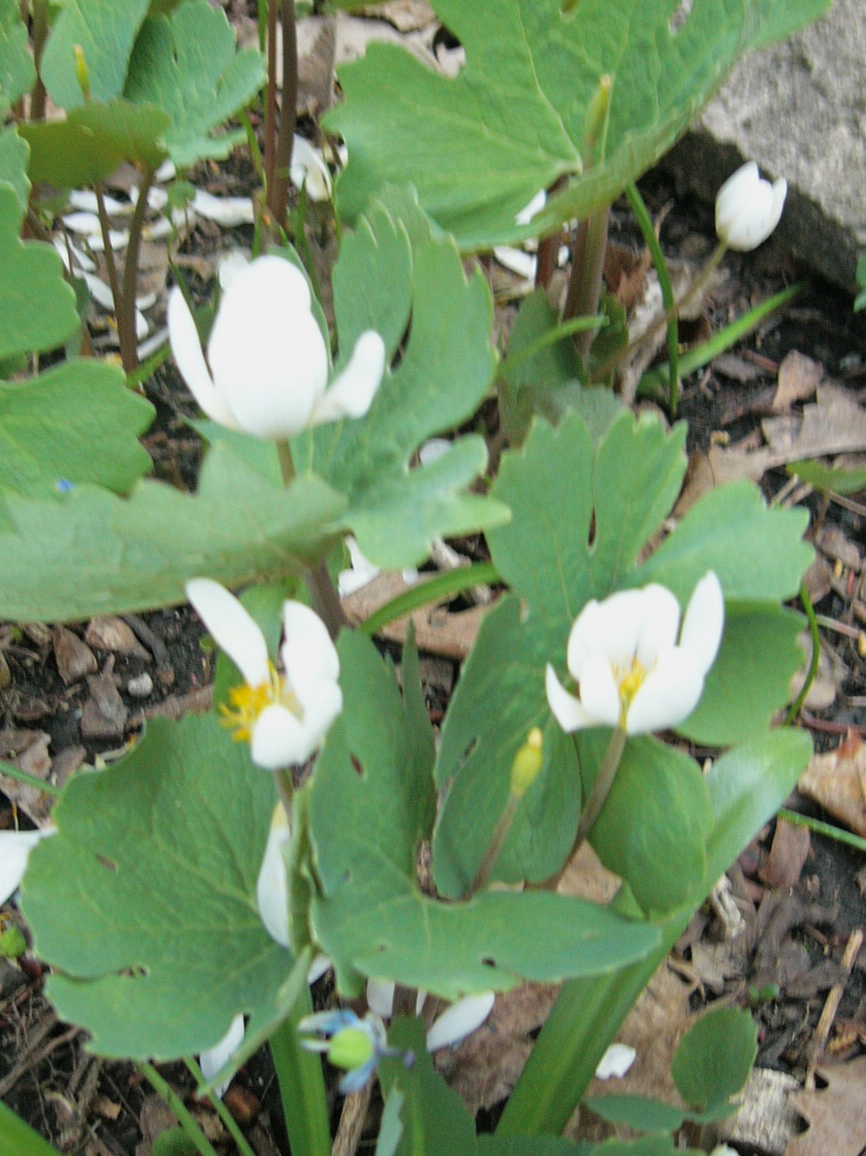
Bloodroot likes and needs water and will wilt in late summer heat if ignored, but comes back strong in the spring and spreads to form a ground cover that is taller than some. You could use it as a taller layer above wild ginger. I've had good luck with it in a spot downhill of a downspout, where I used to put annuals with only mixed success.
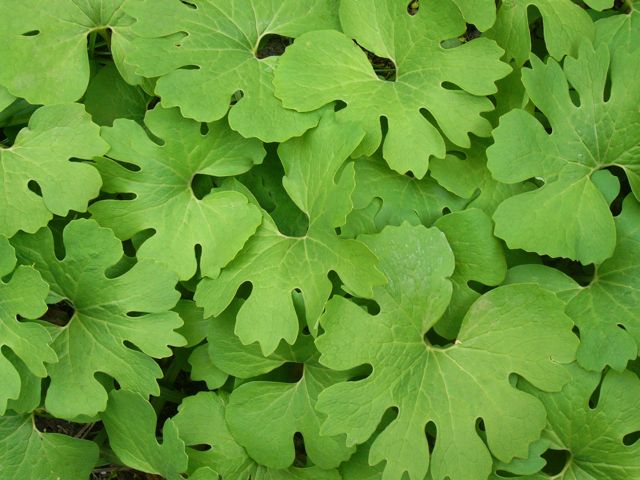
- Log in to post comments
Canadian wild ginger
Canadian Wild Ginger, Asarum canadense, is listed by the USDA as found throughout most of the eastern half of the US, and botanical records indicate it's native from Maine to Mississippi, although now vulnerable to habitat destruction in the central US. It has done well in regenerated deciduous woodlands, and I have seen it in natural settings in Wisconsin as well as in Chicago area forest preserves.
A hardy shade perennial that needs moisture, wild ginger has violet-like leaves on slightly fuzzy stems, and grows about 4" above the ground, forming a nice cover. Small deep yellow flowers appear in early spring on some plants, but most spreading occurs through the tubular roots. In masses, it's a good alternative to pachysandra, and looks beautiful as a low border in front of ferns. The roots do have a mild ginger aroma and flavor. While traditional Chinese medicine and some American folk remedies use the roots, studies reveal that Asarum contains aristocholic acid, a naturally occuring toxin linked to kidney and renal problems, so amateur ingestion is discouraged. The stems and flowers are not edible.

- Log in to post comments
Cardinal flower
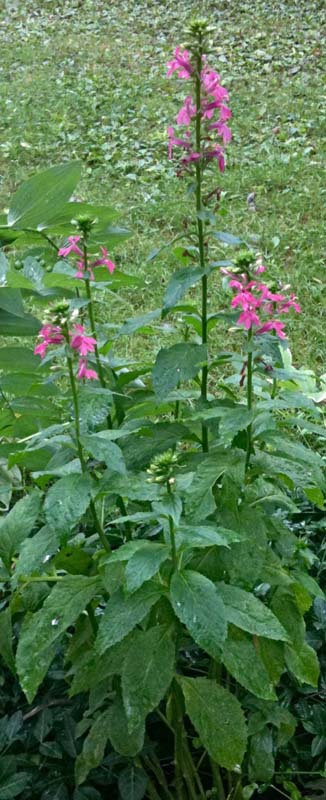 Lobelia cardinalis L. a native perennial of the Campanulaceae (Bellflower) family, is commonly known as Cardinal flower, due to its usually being found in the wild with red blooms. A daintier cousin of the Great Blue Lobelia, it grows slowly during the spring, eventually reaching 1 to (supposedly) 6 feet tall, with delicate but colorful blooms appearing in late summer at the end of long stems. It favors dappled sunlight to fairly shady spots, appreciates water and tolerates occasional flooding; the specimen shown here lives in a relatively moist back corner of my yard that receives almost no direct sunlight during the growing season. The full red variety, which relies on pollinators such as hummingbirds attracted to its color, can be hard to find in greenhouses and nurseries; often you'll find cultivars such as this pink variety shown, or cardinalis-siphilitica hybrids.
Lobelia cardinalis L. a native perennial of the Campanulaceae (Bellflower) family, is commonly known as Cardinal flower, due to its usually being found in the wild with red blooms. A daintier cousin of the Great Blue Lobelia, it grows slowly during the spring, eventually reaching 1 to (supposedly) 6 feet tall, with delicate but colorful blooms appearing in late summer at the end of long stems. It favors dappled sunlight to fairly shady spots, appreciates water and tolerates occasional flooding; the specimen shown here lives in a relatively moist back corner of my yard that receives almost no direct sunlight during the growing season. The full red variety, which relies on pollinators such as hummingbirds attracted to its color, can be hard to find in greenhouses and nurseries; often you'll find cultivars such as this pink variety shown, or cardinalis-siphilitica hybrids.
- Log in to post comments
Celandine poppy
Celandine poppy, Stylophorum diphyllum, is a native woodlands perennial of the poppy family that is found in a few counties in Illinois, including Cook County, and is threatened by the invasive garlic mustard. It produces inch-long, hairy seed pods (below right) and small numbers of attractive, delicate yellow flowers throughout mid-summer.
 It is said to colonize well and allegedly can be used as a ground cover. I tried introducing some in the hot, dry summer of 2012 in a spot that ends up bare in late summer after earlier bloomers die back, and it did well at the base of a tree in a relatively moist, shady area, and came back in 2013. I planted more in 2013 and 2014 in a shady, relatively moist area and they have thrived. The yellow blooms often arrive coincident and contrasting nicely with the blue of Virginia bluebells.
It is said to colonize well and allegedly can be used as a ground cover. I tried introducing some in the hot, dry summer of 2012 in a spot that ends up bare in late summer after earlier bloomers die back, and it did well at the base of a tree in a relatively moist, shady area, and came back in 2013. I planted more in 2013 and 2014 in a shady, relatively moist area and they have thrived. The yellow blooms often arrive coincident and contrasting nicely with the blue of Virginia bluebells.
- Log in to post comments
Culver's root
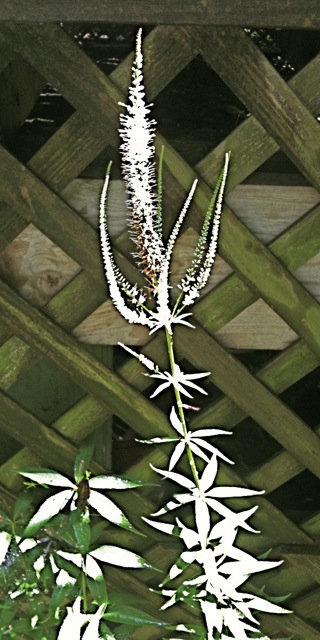 Culver's root, Veronicastrum virginicum, is a kind of wild snapdragon. Nurseries will usually say it needs "part sun" but I planted a test specimen a couple years ago in a spot that gets nothing before noon, and then only mottled light, and it did pretty well despite all that shade, so I put in a few more. These get real tall, easily shooting up to 3' by late spring and over 4' by late summer; you may ned to tie them up unless they are bunched, because they will bend to seek out more sun.
Culver's root, Veronicastrum virginicum, is a kind of wild snapdragon. Nurseries will usually say it needs "part sun" but I planted a test specimen a couple years ago in a spot that gets nothing before noon, and then only mottled light, and it did pretty well despite all that shade, so I put in a few more. These get real tall, easily shooting up to 3' by late spring and over 4' by late summer; you may ned to tie them up unless they are bunched, because they will bend to seek out more sun.
The totally native variety may only have white flowers, but greenhouses tend to have purple varieties. They can have anywhere from 4 to 7 leaves, bearing a vague resemblance to plants seen on the cover of Sgt. Pepper.
- Log in to post comments
False Solomon's seal

False solomon's seal is easily confused with its namesake, Solomon's-seal, or Polygonatum biflorum. You can tell the "false" one by its flowers (above) and seeds (below).
This perennial does not spread much, but is considered disease-resistant and rugged.
- Log in to post comments
Foamflower
Tiarella cordifolia, or foamflower (sometimes "Allegheny foamflower"), is a groundcover perennial native to upper North America (endangered in Wisconsin) that has been cultivated and hybridized. A popular variation, shown here, is the "Brandywine" which features darker, even burgundy veining amidst bright green grapevine-shaped leaves with an interesting texture.
This native was able to thrive in a dark, shady area where I'd had trouble getting anything to grow, and looks great along a path or pond edge. For about 6-8 weeks in spring it shoots up a racene, a tall stalk of tiny, fluffy white flowers, hence the name. It spreads slowly but surely over time. During the season the leaves become darker, and bronze in the fall if you don't let your patch dry out in August heat.
- Log in to post comments
Goat's Beard
 Goat's beard, Aruncus dioicus, sometimes spelled goatsbeard and sometimes called White goatsbeard, is a wide-ranging woodland perennial of the rose family native to North America, particularly the northeast, that also calls Europe and Russia home. By mid-summer it forms large, showy, astilbe-like clusters. First pic here shows the blooms in formation as yellow-green spikelets; see below for what they look like full-blown.
Goat's beard, Aruncus dioicus, sometimes spelled goatsbeard and sometimes called White goatsbeard, is a wide-ranging woodland perennial of the rose family native to North America, particularly the northeast, that also calls Europe and Russia home. By mid-summer it forms large, showy, astilbe-like clusters. First pic here shows the blooms in formation as yellow-green spikelets; see below for what they look like full-blown.
Goat's beard likes moist soil and dappled shade the best but seems extremely well-suited to the clays and loams of the North Shore. I planted several in spots that get little morning sun, only a few hours in the afternoon. Expect the typical "first year sleep, second year creep, third year leap," and with more than minimal sun they can become almost bushlike. Dense and leafy, good for filling in woodland edges, among the first to start shooting up in April, and they take up spaces the bluebells abandon in June. The blooms last nearly a month and then, unless knocked down by storm, form dried flowers with seeds that provide shelter for pollinators and food for birds.
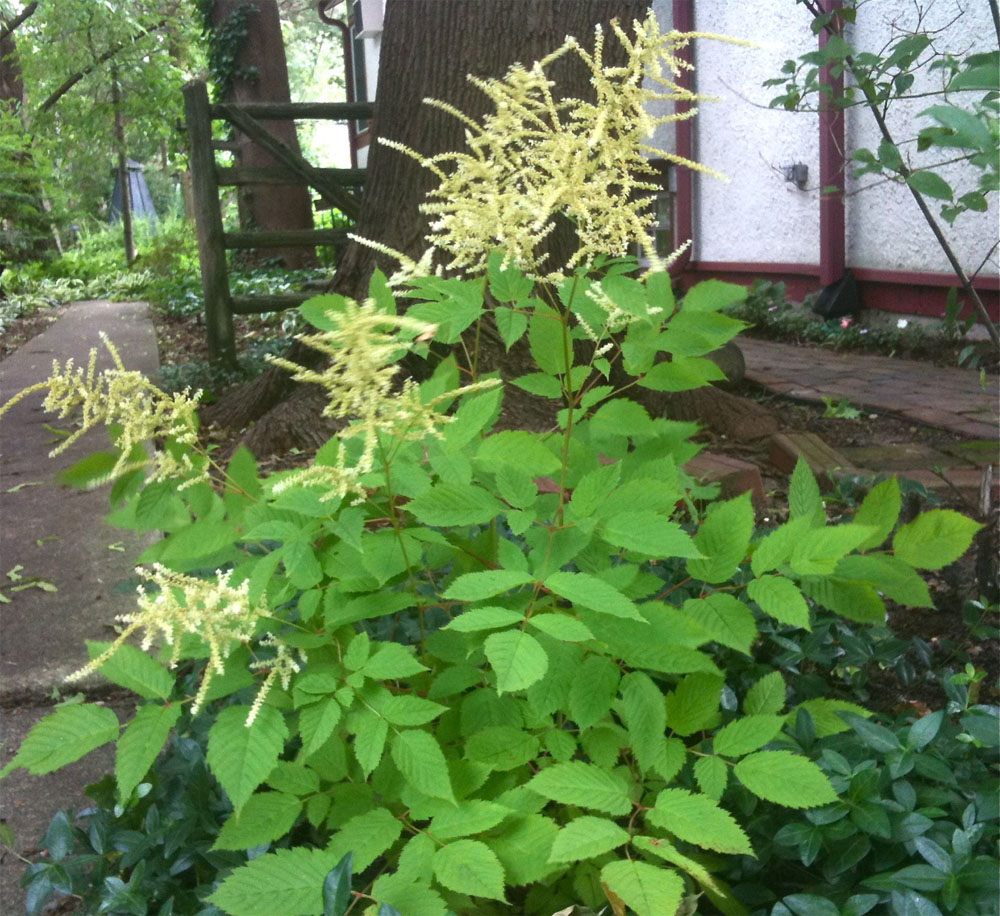
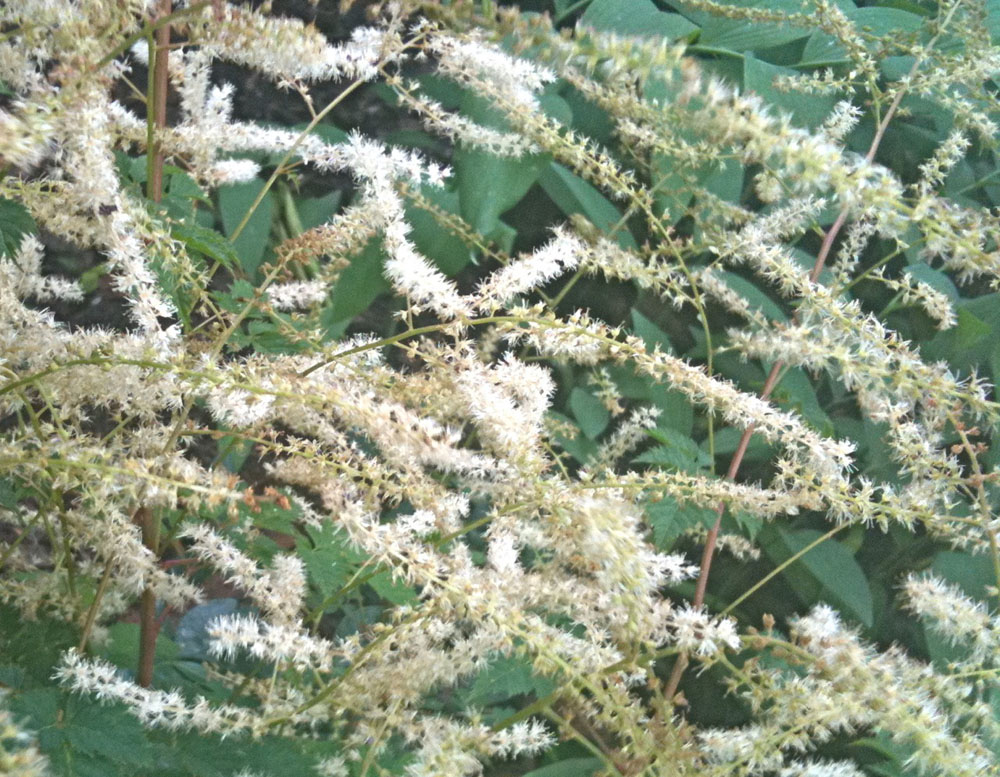
- Log in to post comments
Great Blue Lobelia
This striking lobelia is a perennial of the Campanulaceae (Bellflower) family, and is found native in most of Illinois. It grows from 1-6 feet tall with showy late summer violet blooms at the end of long stems. It likes a touch of partial sun, but grows albeit slowly in even very shady areas. If left to wilt in too much direct glare it has a hard time recovering that season and looks scraggly. It tolerates most conditions well and in my experience is happier with frequent watering in hot, dry conditions.

- Log in to post comments
Jack-in-the-Pulpit
 Jack-in-the-Pulpit, Arisaema triphyllum, is a beautiful woodland plant said to be native to all Illinois counties, but not all that common in gardens. The name is also used to refer to two very similar subspecies.
Jack-in-the-Pulpit, Arisaema triphyllum, is a beautiful woodland plant said to be native to all Illinois counties, but not all that common in gardens. The name is also used to refer to two very similar subspecies.
 This delicate plant, that some botanists call stemless, is always a joy when it returns in spring. A slender shoot appears, growing to a foot or more in height, then unfurls into a trifoliate fan. On the stalk then appears a curling, purple hood, which unfolds to reveal a green raspberry-like structure, or corm. The fanciful resemblance to a monk or cleric shrouded in a hood or high collar lends the plant its name.
This delicate plant, that some botanists call stemless, is always a joy when it returns in spring. A slender shoot appears, growing to a foot or more in height, then unfurls into a trifoliate fan. On the stalk then appears a curling, purple hood, which unfolds to reveal a green raspberry-like structure, or corm. The fanciful resemblance to a monk or cleric shrouded in a hood or high collar lends the plant its name.
Jack-in-the-Pulpit loves dense, shady, moist areas with acidic soil. The soil is best when undisturbed, and covered with a layer of leaves in winter, the conditions one would find under decidious trees in the wild; the acidic leaf cover inhibits competing plants and help Jack return in spring.
Jack-in-the-Pulpit arrives after the silla and Virginia bluebells have died back, filling a nice gap during May and June. Certain gnats and thrips pollinate its odd bloom. In summer, the corm of this Illinois woodland native turns bright red. However, after that it is touch and go as to whether it will last into summer heat; if it gets hot and dry, say goodbye til next year. Assuming some soil moisture, however, it'll come back even bigger, and is said to reach up to two feet tall. The specimens below, from a planting a decade old, are about 15" tall and each leaf is about 9" long.
- Log in to post comments
Jacob's ladder
Jacob's-ladder (Polemonium reptans) is another perennial native to Illinois that met my requirements of being able to handle a fair amount of shade and moisture, and it's flourished in a spot where all its predecessors died. A member of the phlox family, featured in the Botanic Gardens Native Plant Garden, and approved for Illinois highway planting by the Federal Highway Administration, it produces handsome little bushlike sprays of up to 1-1/2' tall, with light blue flowers in mid spring and beyond. The leaves are compound and can look almost fernlike. In the wild it prefers woodlands or areas along rivers. If looking for native variety make sure to get reptans. Note that some cultivated variegated varieties are also available.
- Log in to post comments
May Apple
May apple (Podophyllum peltatum) is an exotic-looking member of the barberry family.
The plant consists of a long, thick stalk from which flares an umbrella of irregularly-lobed leaf, with anywhere from 5 to 9 lobes. I read that these get "up" to 1' across, but I routinly get some over 15". I planted a half dozen and the second year they formed a nice little canopy. Within a few years they had tripled.
They migrate around during the dormant season and like to find rocks or walls for support. A few weeks after sprouting and spreading their umbrellas, they develop odd-looking round seed fruits that hang from underneath, along the stem. The fruit is edible, hence the name, but not the seeds or any other part of the plant.
Like many shade perennials, may apples need to be watched so they don't wilt in the heat. But unless burnt, they will revive with some evening sprkinkling and can last into July. Well worth it. A breathtaking area native plant that makes me wish I'd planted it en masse.
For more about native plants, especially those that do well in shade/moist areas, see the "book" on this website, Gardening with Native Plants in Shady Evanston.
- Log in to post comments
Gallery:
Meadow anemone
Meadow anemone (Anemone canadensis), as it's usually called in Illinois, is also known as Canadian anemone, windflower, or round-headed thimbleweed. A perennial wildflower of the Ranunculaceae (buttercup) family, it features dramatically jagged leaves on tall stalks. Small, usually-five-petaled white flowers with yellow centers appear in spring in mature plants and can last through summer. Native to the U.S. east of the Rockies, meadow anemone has disappeared from most southern and border states, is in critical status in much of the north, and is considered "vulnerable" in Illinois. So planting it supports a species that could use a little help.
 Naturally often found on river or pond banks, this pretty wild buttercup tolerates varying sun and shade conditions, ideally a mix of both during the day, and in favorable conditions will form dense cover a foot or two tall, sometimes aggressively. I put it on a terrace below a cement sidewalk where other plants struggled, and it thrived despite (or maybe because of) constant runoff from the walk. Too-dense thickets can be thinned in the fall.
Naturally often found on river or pond banks, this pretty wild buttercup tolerates varying sun and shade conditions, ideally a mix of both during the day, and in favorable conditions will form dense cover a foot or two tall, sometimes aggressively. I put it on a terrace below a cement sidewalk where other plants struggled, and it thrived despite (or maybe because of) constant runoff from the walk. Too-dense thickets can be thinned in the fall.
Some large, impressive patches of this species are featured on the banks of the rain garden at the Daniel F. and Ada L. Rice Plant Conservation Science Center at the Chicago Botanic Garden.
- Log in to post comments
Midland Shooting Star
Midland Shootingstar (Dodecatheon meadia), one of about a dozen or two shootingstar varieties, a type of primrose, is a popular wildflower found throughout the eastern US, including most Illinois counties, and a really cool perennial. The first year I planted them they didn't do much. The next year they put out big, floppy-eared lettuce-type leaves, out of which suddenly shoot up stalks of up to 18", from which hang little, delicate, tubular clumps of flowers.
The ground plant and the top flower are hard to get all in one picture so I show two plants here; note, the big leafy things up top are not shootingstar, but May apples butting into the picture.
The flowers, after getting pollinated, drop their petals, then eventually their seed cases, and the leafy ground plants remain for a while. They make a nice contrast to the May apples. However they don't play defense very well and are susceptible to getting crowded out by more aggressiv plants.
This neat addition to a garden likes partial sun but can take a little more or less than that. It does well on slopes and has thrived in a difficult terrace area of mine that tends to get hit hard by freeze.
- Log in to post comments
Ostrich ferns
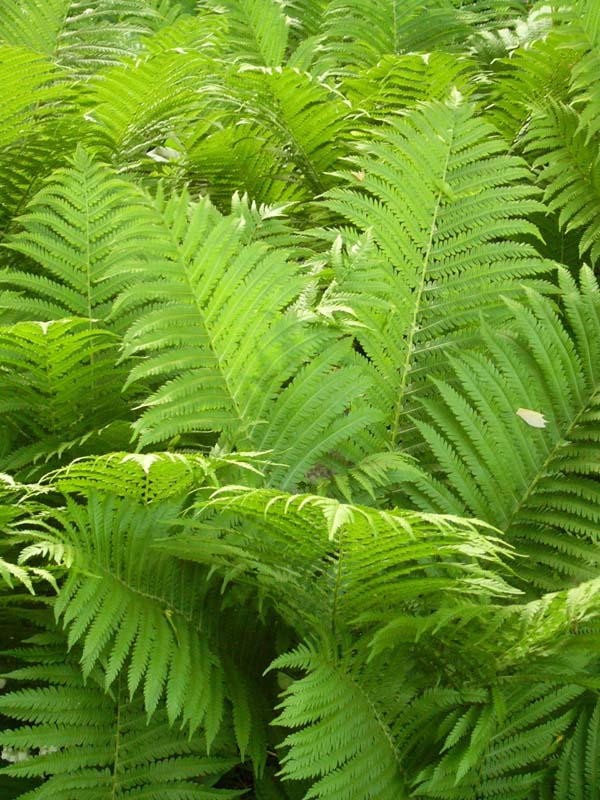 The lovely ostrich fern, Matteuccia struthiopteris, is a member of the Onocleaceae fern family native to North America. A perennial that will move about the garden from year to year searching for optimal location, it first appears in spring as tightly wound curls from a brown stumplike root, then fans out into broad, compound leaves that can reach 5 feet in height, although 2'-3' is more typical. It occurs naturally in scattered locations in northern and western Illinois.
The lovely ostrich fern, Matteuccia struthiopteris, is a member of the Onocleaceae fern family native to North America. A perennial that will move about the garden from year to year searching for optimal location, it first appears in spring as tightly wound curls from a brown stumplike root, then fans out into broad, compound leaves that can reach 5 feet in height, although 2'-3' is more typical. It occurs naturally in scattered locations in northern and western Illinois.
The ostrich fern reproduces primarily by "fertile" leaves that appear brown in late summer and produce spores on the underside that are released the next spring. However, it can also send out rhizomes that help populate an area in clusters. These ferns tolerate shade and water well, and in fact need watering during dry spells; they usually wilt come the heat of July and August unless well-watered and/or protected from direct sun. They are also fragile and don't bounce back during the season if trampled, but will try again next spring.
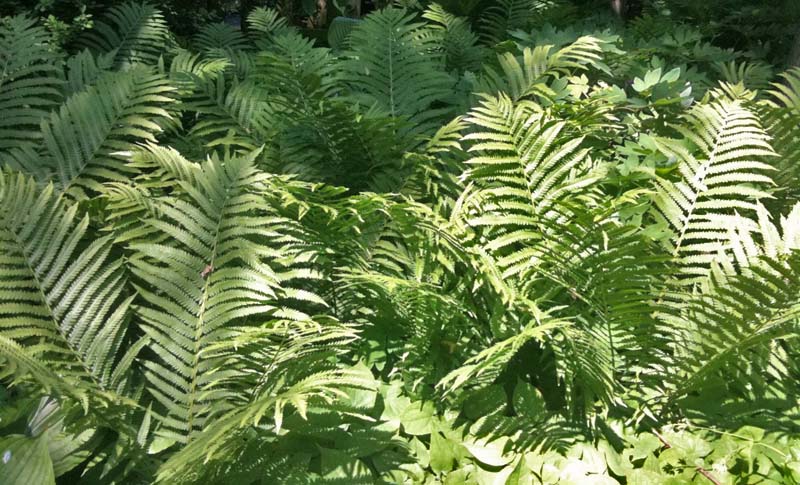
- Log in to post comments
Prairie dropseed
 Prairie dropseed, Sporobolus heterolepis, is a unique perennial grass of the Poaceae grass family native to Illinois and the midwest, and a true prairie grass. It forms beautiful fountain-shaped tufts of fine, narrow leaves, up to 3' across in mature specimens. In summer, it sends up one or more shoots from the center that can reach up to 2' tall. These culms produce large, lacy, arrowhead-shaped panicles in late summer and fall, as seen below. Wind-pollinated, these seeds are primarily how the dropseed spreads.
Prairie dropseed, Sporobolus heterolepis, is a unique perennial grass of the Poaceae grass family native to Illinois and the midwest, and a true prairie grass. It forms beautiful fountain-shaped tufts of fine, narrow leaves, up to 3' across in mature specimens. In summer, it sends up one or more shoots from the center that can reach up to 2' tall. These culms produce large, lacy, arrowhead-shaped panicles in late summer and fall, as seen below. Wind-pollinated, these seeds are primarily how the dropseed spreads.
While, like most prairie grasses, it prefers ample sun, prairie dropseed is hardy enough to tolerate moderately shady conditions. This example shown here has survived for several years on a parkway plot, under a maple tree, that receives only an hour or two of direct sun daily.
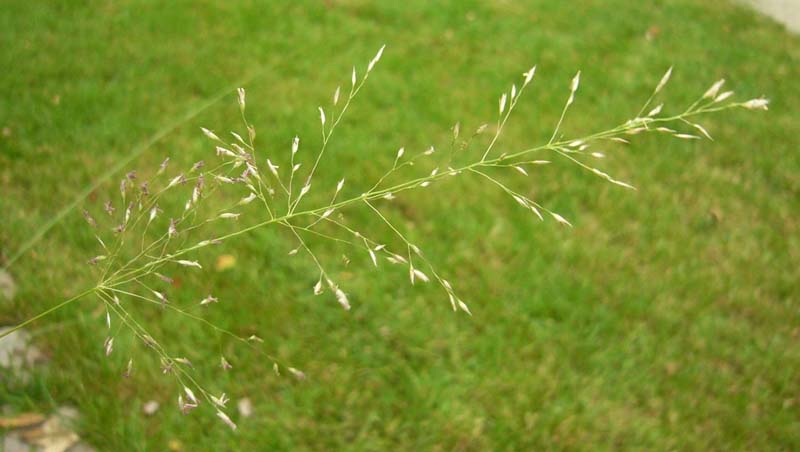
- Log in to post comments
Prairie trillium
Prairie trillium (Trillium recurvatum), found in every county in Illinois, has become one of my favorites. A bulb-based lily family member that likes shade and humusy soil in hardwood woodlands, it has three mottled or speckled leaves and a small, delicate dark red flower that appears in mid spring and never fully opens. A shy plant that needs some help to keep the lilies of the valley, scilla, and other bulb-based competition away. Supposedly hard to get going, but reportedly will self-colonize and form large masses given the right conditions. I have just one or two specimens and they seem content to be orphans. Sometimes this is called red trillium but that name is more properly applied to the similar but taller, different (Trillium erectum).
- Log in to post comments
Solomon's-seal
Solomon's-Seal, Polygonatum biflorum, is a member of the lily family found naturally in most counties of Illinois and featured in the Botanic Gardens Native Plant Garden, and approved for Illinois highway landscaping by the Federal Highway Administration. Solomon's-Seal is distinguishable from False solomon's seal by its flowers, little pale-colored tubes that appear for a few weeks in spring, then turn into pearl-like seed pods, dangling underneath the upper part of the stem (bottom).
Solomon's-seal, a natural woodland inhabitant, likes shade and moisture. In its common woodland incarnations, it will form graceful arches about 10"-18" in length. Some cultivars are variegated and some grow much larger; I put in a couple specimens that apparently liked their wet, shady location, and they wood be over 4' tall if stood straight up.
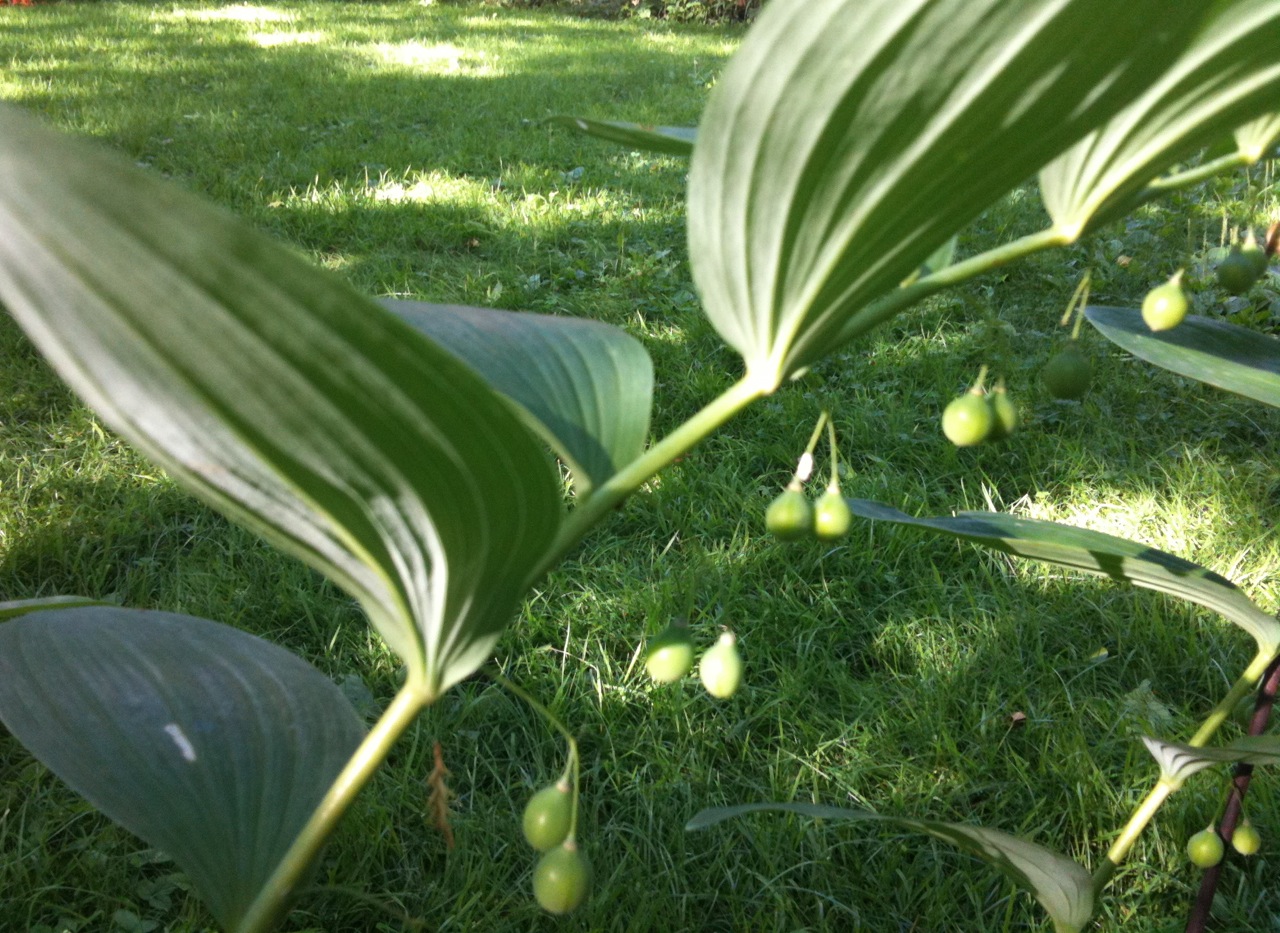
- Log in to post comments
Spotted Joe-Pye Weed
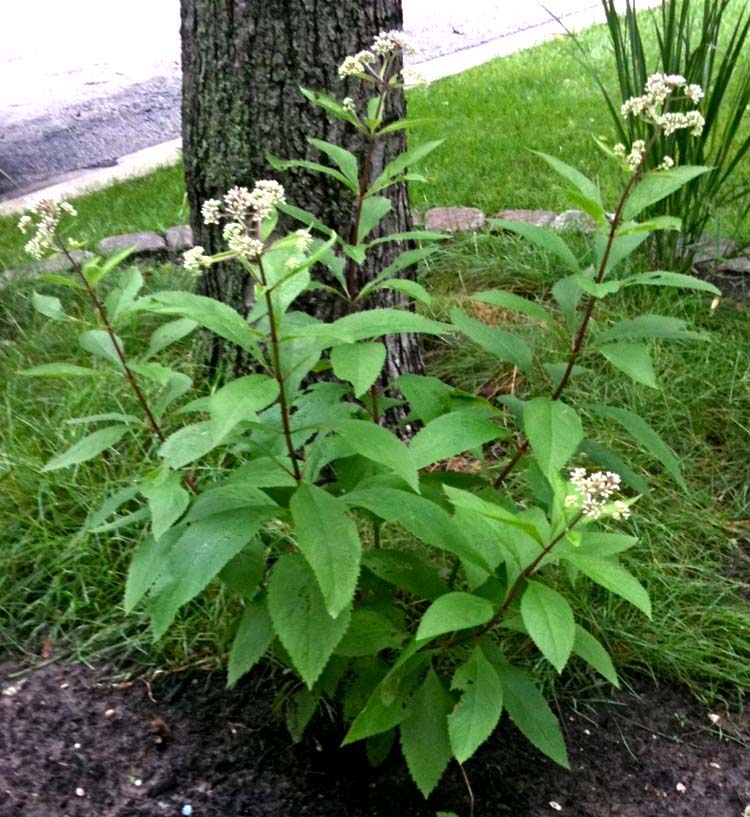 Spotted Joe-Pye Weed, Eupatoriadelphus maculatus, sometimes called spotted trumpetweed, is a hardy and fast-growing long-stemmed perennial in the aster family, indigenous to the eastern U.S. from the Great Plains to New England. In Illinois, it's found naturally in counties mainly in the northern half of the state. Spotted Joe-Pye Weed is more shade-tolerant and moisture-loving than its cousin, Sweet Joe-Pye Weed (Eupatoriadelphus purpureum), and does well in woodlands-type settings, even with occasional temporary inundation.
Spotted Joe-Pye Weed, Eupatoriadelphus maculatus, sometimes called spotted trumpetweed, is a hardy and fast-growing long-stemmed perennial in the aster family, indigenous to the eastern U.S. from the Great Plains to New England. In Illinois, it's found naturally in counties mainly in the northern half of the state. Spotted Joe-Pye Weed is more shade-tolerant and moisture-loving than its cousin, Sweet Joe-Pye Weed (Eupatoriadelphus purpureum), and does well in woodlands-type settings, even with occasional temporary inundation.
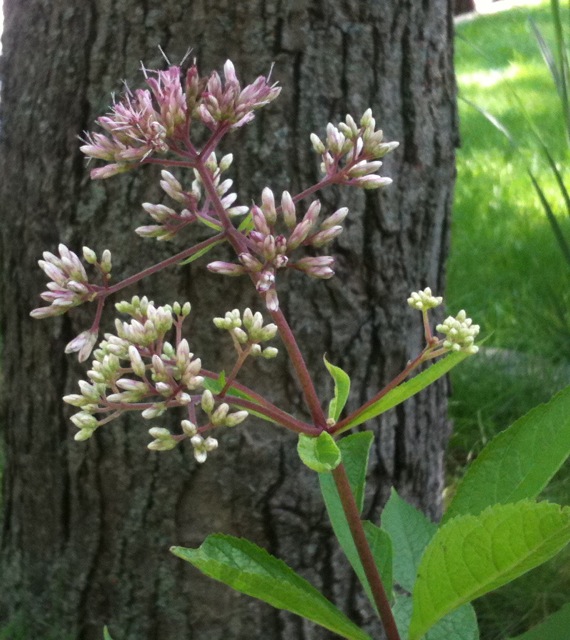
Spotted Joe-Pye is recognizable by its purple stems (sometimes covered with downy fibers). It reappears in the spring as small purple shoots creeping along the ground, then grows rapidly during the season to a stemmy, gently arching plant of between 3' and 6' tall depending on soil conditions (the specimen shown above has to compete with maple roots for water and nutrients). In late summer, flat-headed pinkish to pale-purple bloom clusters (seen above) appear. The plant shown below is an example of its rapid growth: it grew from 1" shoots to the 5 feet tall pictured in about three months. Reportedly, it will naturalize and multiply given the opportunity.

- Log in to post comments
Violets
The common blue violet (Viola sororia), also called dooryard violet, meadow violet, or sister violet, is overlooked by many gardeners these days, perhaps because it shows up uninvited in lawns and gardens, but back in the day it was beloved, and it has been the state flower of Illinois for 100 years, following a 1907 contest in which it was selected by Illinois schoolchildren. Featured in the Botanic Gardens Native Plant Garden, and approved for Illinois highway planting by the Federal Highway Administration, its valentine-shaped leaves and pretty little deep purple blooms can be found throughout the upper midwest. Years ago, rather than throw out all the violets I plucked from my lawn, I started re-planting the beefier-looking specimens near the bottom of my deck stairs, and I've been rewarded with showy, bushy masses that produce bigger leaves and more blossoms than the little lurkers that try to sneak into places they're unwelcome.
- Log in to post comments
Virginia bluebells
 Mertensia virginica, commonly known as Virgnia bluebells, is a native woodland perennial found in most Illinois counties, including Cook County, and is featured in the Botanic Gardens Native Plant Garden. It pops up through the silla in mid-spring, and rapidly grows into big, spreading, bouquet-like plants of up to 2-1/2' tall, with delicate lavender-blue bell-shaped flowers that bloom for up to a month.
Mertensia virginica, commonly known as Virgnia bluebells, is a native woodland perennial found in most Illinois counties, including Cook County, and is featured in the Botanic Gardens Native Plant Garden. It pops up through the silla in mid-spring, and rapidly grows into big, spreading, bouquet-like plants of up to 2-1/2' tall, with delicate lavender-blue bell-shaped flowers that bloom for up to a month.
Virginia bluebells like the cool and wet of early spring and can even tolerate a late snow. They wilt once it gets hotter or drier, usually by late May in northern Illinois. The big foliage is kind of messy, but rather than cut it, I tie it back, or at least wait until the bluebells have dropped their seeds. Virginia bluebells tolerate light shade to partial sun as well as moisture, and if not cut back too aggressively, will tend to colonize, and so make a good choice for difficult shady, wet areas, especially along pathways or around trees.
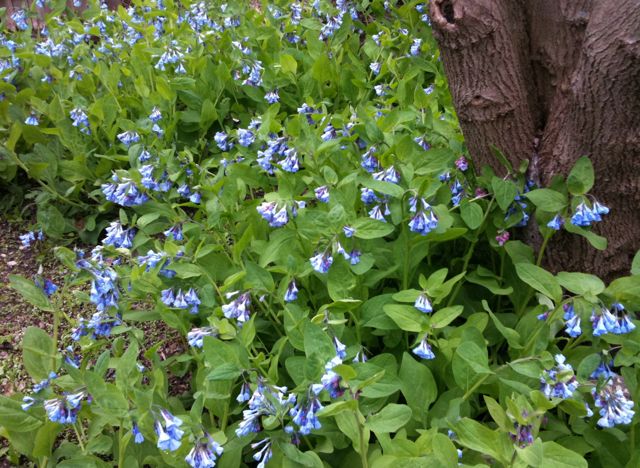
- Log in to post comments
Native Plants website links
The following are some good websites for more info on native plants. Click on the words in red to visit the site. The U.S. Dept. of Agriculture Illinois Native Plant Guide (NPG) is an online list of native Illinois pants with sun and soil conditions listed. You can use the online index or download the entire thing. The Lady Bird Johnson Wildflower Center at the University of Texas has an excellent database, searchable by state, light and soil conditions, and even bloom time, with hundreds of species and good information for each including, for purists, original areas of distribution. Illinois Wildflowers is a really comprehensive site maintained as a labor love by John Hilty, with large pictures and excellent scientific info. Chicago Wilderness is a site with a nice list of native Illinois plants in the 225,000-acre wilderness reserve. Happy hunting!
- Log in to post comments
